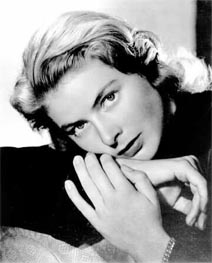 |
||
Main Page |
People
Page |
|
Ingrid Bergman Occupation: Actress Born: August 29, 1915 Stockholm, Sweden Died: August 29, 1982 Education: Royal Dramatic Theater School, Stockholm Links Ingrid Bergman's Biography in the Internet Movie Database. Ingrid Bergman's Internet Movie Database Filmography entry. |
A highly popular actress known for her fresh, radiant beauty, Ingrid Bergman was a natural for virtuous roles but equally adept at playing notorious women. In 1933, fresh out of high school, she enrolled in the Royal Dramatic Theater and made her film debut the following year, soon becoming Sweden's most promising young actress. Her breakthrough film was Gustaf Molander's Intermezzo (1936), in which she played a pianist who has a love affair with a celebrated and married violinist. The film garnered the attention of American producer David O. Selznick, who invited her to Hollywood to do a remake. In 1939 she co-starred with Leslie Howard in that film, which the public loved, leading to a seven-year contract with Selznick.
Selznick promoted Bergman's wholesomeness from the beginning. He loaned her to other studios for Adam Had Four Sons (1941), Rage in Heaven (1941) and Dr. Jekyll and Mr. Hyde (1941). In the latter film Bergman's insistence on playing the role of the prostitute rather than the good fiance proved a shrewd move. She then starred with Humphrey Bogart in Casablanca (1942), perhaps her most popular film, and was also featured with Gary Cooper in For Whom the Bell Tolls (1943). She won her first Oscar for her portrayal of a wife nearly driven mad by Charles Boyer in Gaslight (1944).
The following year, Bergman had starring roles as a New Orleans vixen with Cooper in Saratoga Trunk, a psychiatrist opposite Gregory Peck in Alfred Hitchcock's Spellbound and a nun opposite Bing Crosby's priest in The Bells of St. Mary's. Bergman's last picture under contract to Selznick, and probably her finest work, was Hitchcock's Notorious (1946), an emotionally complex espionage film in which she played a woman bent on self-destruction until redeemed by the love of a federal agent, played by Cary Grant.
Bergman then went freelance, first playing a prostitute in Arch of Triumph (1948) and then the constrasting Joan of Arc (1948), a role she had played to great acclaim on Broadway in 1946. Her final film for Hitchcock was the 1949 period piece, Under Capricorn.
Bergman's personal and professional life went into a tailspin in 1949 after she left her husband, Dr. Peter Lindstrom, for Italian director Roberto Rossellini. She married Rossellini, a union which produced three children and six films of varying artistic merit, beginning with Stromboli (1950). The international scandal tarnished her innocent image and, extraordinarily, led to her being barred from American films for 7 years.
Bergman's career began to recover with her appearance in Jean Renoir's Paris Does Strange Things (1956). She made a triumphant return to Hollywood with Anastasia (1956), for which she won her second Academy Award, a sign that her sins had been officially forgiven. In 1958 her marriage to Rossellini was annulled and she married theatrical producer Lars Schmidt.
Thereafter, Bergman began branching out into TV and stage roles. The films of this later period of her career were of varying quality. She received a third Academy Award for her supporting role in Murder on the Orient Express (1974) and won acclaim for her co-starring role with Liv Ullmann in Ingmar Bergman's Autumn Sonata (1978), an intense drama about a pianist and her daughter.
Bergman's health began to fail in the late 1970s, though she fought off cancer long enough to complete a TV movie, A Woman Called Golda (1982), in which she portrayed Israeli Prime Minister Golda Meir. The performance earned her an Emmy, her final honor.


